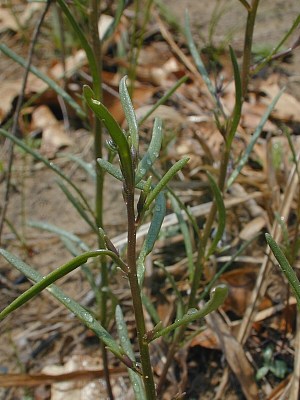Description: This plant is a biennial or winter annual up to 1½' tall. Often, there are multiple leafy stems at the base of the plant, but the flowering stalks are little branched. Both the stems and flowering stalks are green to reddish green and glabrous. The leaves are up to 1½" long and 1/8" across. They are linear to oblong-linear, glabrous, smooth along the margins, and sessile. The leaves on the taller flowering stalks are alternate, while the leaves on the lower vegetative stems are usually opposite.

Each flowering
stalk terminates in a spike-like raceme of flowers up to 8" long. Each
flower is up to ½" long, consisting of a calyx with 5 teeth and a
two-lipped corolla with a slender nectar spur. The calyx is green to
purplish green and may be slightly pubescent. The corolla is light blue
to medium blue-violet; its upper lip is divided into 2 rounded lobes,
while the lower lip is divided into 3 lobes that are rounded and
spreading. The throat of the corolla is white with 2 rounded ridges.
The nectar spur can be straight or recurved. There is a short slender
pedicel at the base of each flower; at the base of the pedicel, there
is a single bract that is short and linear. The blooming period occurs
from mid-spring to mid-summer and can last 2-3 months for a colony of
plants. Only a few flowers bloom simultaneously on each raceme. Each
flower is replaced by a seed capsule that splits open to release the
flattened smooth seeds. These seeds can be blown about by the wind. The
root system consists of a stout taproot. This plant spreads by
reseeding itself.

Cultivation:
The
preference is full sun and dry sandy soil where there is little
competition from other plants. Rocky soil, mesic conditions, and a
little shade are also tolerated.
Range & Habitat:
The native Blue Toadflax occurs occasionally in sandy areas in the
northern half
of Illinois, otherwise it is uncommon or absent (see Distribution
Map). Habitats include dry sand prairies, sand dunes, sandy
savannas, thinly wooded bluffs, rocky glades, sandy shoulders of roads,
and sandy fields. Disturbed areas are preferred; occasional wildfires
are beneficial in maintaining populations of this plant.
Faunal Associations:
The flowers are pollinated by bumblebees and other long-tongued bees.
Butterflies and skippers may visit the flowers for nectar, but they are
less likely to be effective at cross-pollination. The caterpillars of
the butterfly Junonia coenia (Buckeye) feed on the
foliage of Blue Toadflax and many other members of the Figwort family.
A stink bug, Cosmopepla carnifex Fab., has been
found on the foliage of this species in sand prairies.
Photographic Location:
Along a path in a burnt-over sandy savanna in Kankakee County, Illinois.
Comments:
Blue Toadflax has reasonably attractive foliage and flowers. Its
appearance is very similar to Nuttallanthus texensis
(Southern Blue Toadflax), but the latter has larger flowers (up to 1"
long) and bumpy seeds. Blue Toadflax is also related to the introduced Linaria
vulgaris (Yellow Toadflax), but the latter has larger yellow
flowers (up to 1" long or more). There are other Toadflaxes from
Eurasia that occur primarily in sterile waste areas, but they usually
have smaller flowers (¼" or less). Blue Toadflax superficially
resembles Lobelia kalmii (Kalm's Lobelia), but the
flowers of the latter lack nectar spurs and it usually blooms later in
the year. Another scientific name for Blue Toadflax is Linaria
canadensis.